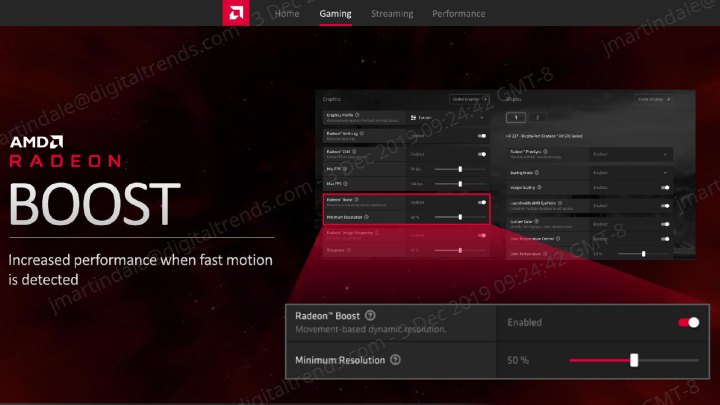AMD’s new-generation Radeon Software suite comes with a number of exciting improvements, but one of the most intriguing is its new Radeon Boost technology. Using dynamic adjustment of resolution during moments of high-speed action and fast movements, AMD claims that it can improve frame rates by almost 40% in some circumstances, dramatically improving the fluidity of animation and reducing input lag, all without impacting image quality by a noticeable factor.
Alongside new generations of graphics cards, both AMD and Nvidia have taken major steps in the past year to improve the quality of gamers’ experiences beyond raw performance. Image sharpening started with AMD and is now available for both red and green team GPU owners, and anti-lag technologies have become common place too. Radeon Boost is something a little different though, and for now at least, remains an AMD exclusive technology.
AMD describes it as “Motion-based dynamic resolution,” technology. It detects when you’re performing fast motion, like in high-speed FPS or RTS games, and adjusts the resolution down to improve your frame rate. The end result is faster, more fluid gameplay without impacting the look of the game. While eagle-eyed gamers may spot a slightly more pixelated image, AMD claims that it should be almost imperceptible to most. This should, in theory, improve your game’s responsiveness too, as higher frame rates help reduce input lag as well.

AMD claims an average improvement of around 23 percent in average FPS for supporting games, with Overwatch notching a near 40 percent enhancement in framerate with Radeon Boost enabled.
The list of supporting games so far includes:
- Overwatch
- PlayerUnknown’s Battlegrounds
- Borderlands 3
- Shadow of the Tomb Raider
- Rise of the Tomb Raider
- Destiny 2
- GTA 5
- CoD WW2
AMD has plans to expand this list in future if the feature proves popular. It’s not something that needs game developers to enable, either, so there’s no real limitation to which games AMD could support with it.
Within the Radeon Software, users can toggle the feature on and off, as well as set a percentage-based “Minimum Resolution,” that the game will downgrade to at times of fast motion. A lower percentage will yield greater performance improvements, but may suffer from more obviously inhibited game-visuals.
If you want to have a play with AMD Radeon Boost yourself, it’s available now as part of the latest AMD Radeon driver update.
Editors' Recommendations
- AMD’s graphics card sales just took a nosedive
- AMD’s canceled GPU could have crushed Nvidia
- Nvidia RTX 50-series graphics cards: news, release date, price, and more
- AMD needs to fix this one problem with its next-gen GPUs
- AMD’s GPUs had a bigger year in 2023 than you might realize




